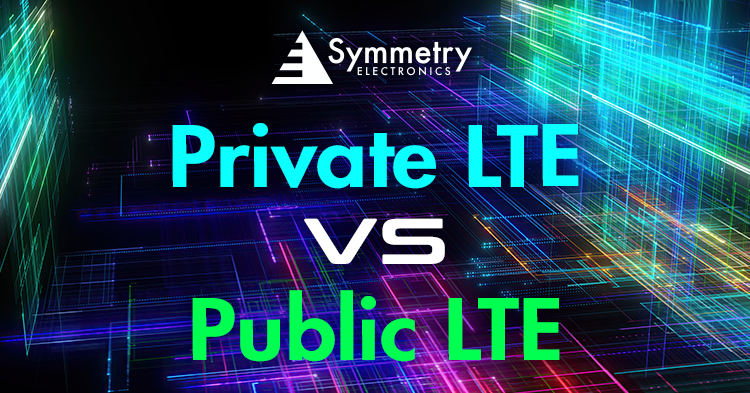- Home
- Symmetry Blog
- Private LTE vs Public LTE
Private LTE vs Public LTE
About Jari Haiston

Long-Term Evolution (LTE) technology has revolutionized the way we access and share data. First implemented in the fourth-generation (4G) wireless communication standard, 4G LTE provides high-speed data and voice communication services over cellular networks. LTE is commonly used in public cellular networks, but it is also being adopted in private networks.
LTE Use Cases
LTE standards were adopted by carriers around 2010, and 4G LTE mobile networks have proven their longevity. 4G LTE technology enables a wide range of use cases across various industries like:
- Mobile Internet Access
- Video Streaming
- VoLTE (Voice over LTE)
- Mobile Gaming
- Internet of Things (IoT) Connectivity
- Remote Work and Collaboration
- Public Safety and Emergency Services
- Fleet Management and Vehicle Telematics
- Digital Signage and Advertising
Key Features of 4G LTE:
As a reliable and widely available connectivity solution, 4G LTE continues to drive innovation and improve experiences across industries and everyday life. Many developers select 4G LTE as their device’s ideal communication standard for the following features:
- Top speeds of 100 Mbps can be achieved with 4G LTE.
- The latency in 4G LTE networks is approximately 50 milliseconds.
- 4G LTE utilizes the available spectrum ranging from 600MHz to 2.5GHz.
- 4G LTE network features are widely adopted and available worldwide. While 4G coverage may be limited in rural areas, it is still more accessible compared to 5G.
What is Public LTE?
Public LTE is a commercial service provided by mobile network operators (MNOs) for the general public. It is the most common form of LTE and is used by billions of people worldwide. According to Public LTE networks are designed to provide high-speed data and voice communication services to mobile devices, such as smartphones, tablets, and laptops.
Additionally, Public LTE networks are licensed by the government, and MNOs are required to follow strict regulations to ensure quality of service and security. These networks are usually available to the public through subscription plans, and the service coverage area is determined by the MNOs.
Public LTE networks are also designed to handle a large number of devices simultaneously. They are optimized for high bandwidth and low latency, making them ideal for data-intensive applications, such as video streaming, online gaming, and cloud computing. Public LTE networks also provide a wide range of services, such as voice over LTE (VoLTE), short message service (SMS), multimedia messaging service (MMS), and mobile hotspots.
What is Private LTE?
Private LTE is a wireless communication technology that is designed for private networks. Private LTE networks are owned and operated by private companies, organizations, or governments. They are designed to provide high-speed data and voice communication services to a specific group of users, such as employees, customers, or guests.
Private LTE networks are licensed or unlicensed, depending on the requirements of the owner. They are designed to be more flexible and customizable than public LTE networks. Private LTE networks can be customized to meet specific needs, such as coverage area, data speed, and security. They can also be integrated with other technologies, such as Wi-Fi, Ethernet, and Bluetooth.
The adoption of private LTE implementation is on the rise. According to Business Newswire, the private LTE global market is expected to reach $10.3 billion by 2028. This growth can be attributed to the fact that private LTE networks are ideal for businesses and organizations that require reliable high-speed wireless communication services for critical applications, such as manufacturing, logistics, and public safety. Private LTE networks can also be used in remote areas where public LTE networks are not available.
The Main Differences Between Public LTE and Private LTE
The main differences between public LTE and private LTE include:
- Ownership: Public LTE networks are owned and operated by MNOs, while private LTE networks are owned and operated by private companies, organizations, or governments.
- Regulations: Public LTE networks are licensed by the government, and MNOs are required to follow strict regulations to ensure quality of service and security. Private LTE networks can be licensed or unlicensed, depending on the requirements of the owner.
- Customization: Private LTE networks are more customizable than public LTE networks. Private LTE networks can be customized to meet specific needs, such as coverage area, data speed, and security.
- Availability: Public LTE networks are widely available to the general public through subscription plans. Private LTE networks are only available to a specific group of users, such as employees, customers, or guests. Should You Use Private or Public LTE for Your Development? Choosing between private and public LTE for your development depends on your specific requirements, resources, and the nature of your project. Here are some factors to consider when deciding which option is more suitable:
- Ownership and Control: Private LTE networks offer full ownership and control to the organization deploying them. This can be advantageous if you require complete control over network management, security, and customization. Public LTE networks, on the other hand, are managed by MNOs providing a more hands-off approach for network management.
- Security and Privacy: Private LTE networks can provide enhanced security and privacy measures compared to public LTE networks. This is especially important for industries handling sensitive data or operating in highly regulated environments. With a private LTE network, you have more control over security protocols, encryption, and access control, allowing you to tailor the network to your specific security requirements.
- Network Coverage and Availability: Public LTE networks typically have wider coverage and availability compared to private LTE networks. MNOs invest heavily in network infrastructure, ensuring broad coverage across urban, suburban, and rural areas. Private LTE networks may be more limited in coverage, especially in remote or hard-to-reach locations. Consider the geographic scope of your development and the availability of public LTE coverage in those areas.
- Scalability and Traffic Management: Public LTE networks are designed to handle high traffic loads and large user bases, making them suitable for applications requiring scalability and supporting a high number of concurrent users. Private LTE networks, on the other hand, can be tailored to your specific requirements, allowing for more focused traffic management and dedicated resources for your development.
- Cost Considerations: Implementing a private LTE network requires upfront investments in infrastructure, equipment, licensing, and ongoing maintenance costs. Public LTE networks, on the other hand, typically operate on a subscription-based model, allowing for predictable costs and avoiding the need for significant capital expenditure. Evaluate your budget and long-term cost projections to determine which option aligns with your financial capabilities.
- Customization and Integration: Private LTE networks provide greater flexibility for customization and integration with existing systems. This is particularly relevant if you have specific technical requirements or if you need to integrate the LTE network seamlessly with other technologies or devices. Public LTE networks, while standardized and widely compatible, may have limitations in terms of customization and integration option
In conclusion, public LTE and private LTE are two different wireless communication technologies designed for different purposes. Public LTE networks are designed to provide high-speed data and voice communication services to the general public, while private LTE networks are designed to provide high-speed and reliable wireless communication services to a specific group of users. Private LTE networks are more customizable than public LTE networks and can be used in remote areas where public LTE networks are not available.

.png)
.png)

.jpg)